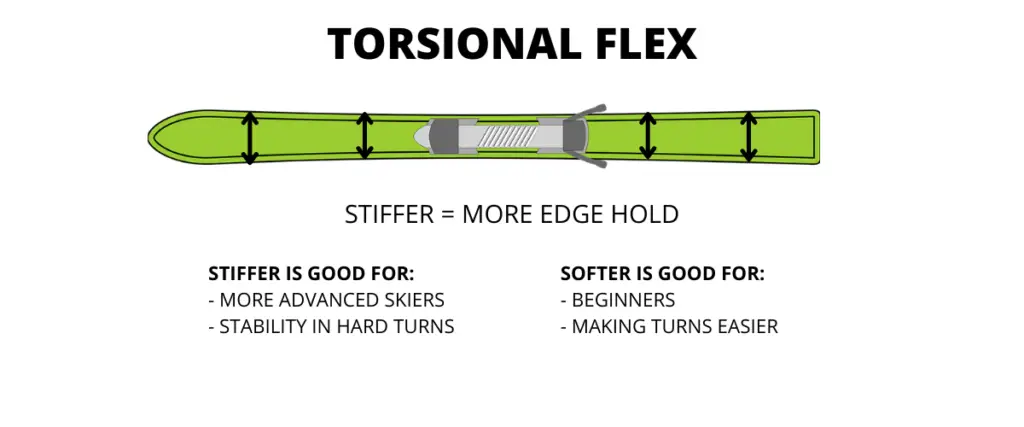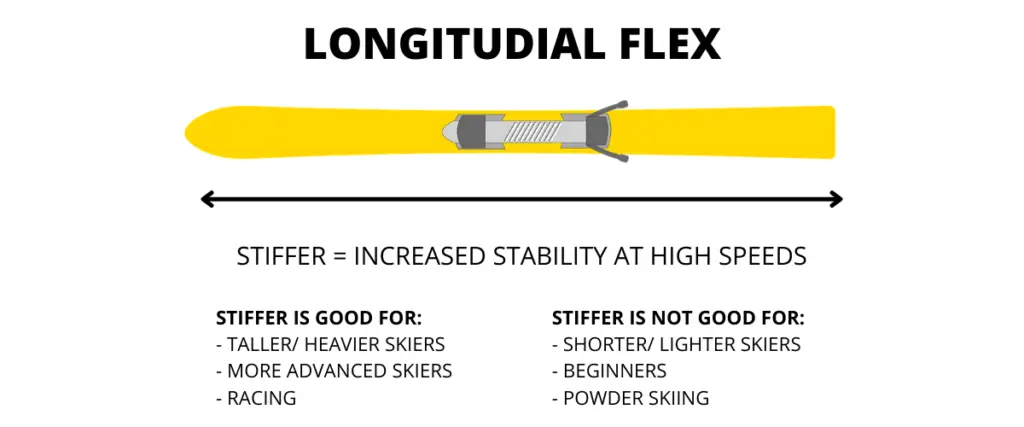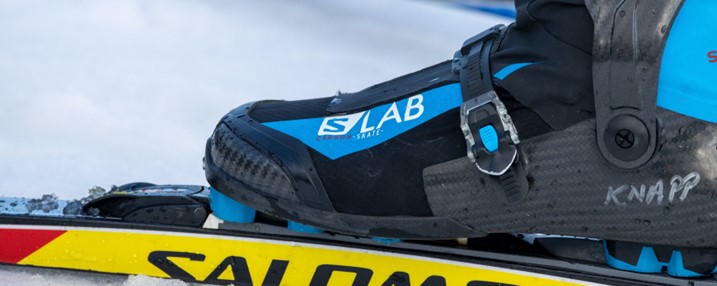It can sometimes be tricky to decide whether you should make the switch to adult skis, or if junior skis are more suitable. In this article I’ll be directly comparing adult and junior skis and discussing the structural differences plus how to figure out which are suitable.
Junior vs Adult Skis
Junior skis are more flexible, shorter and have a smaller waist width compared to adult skis. Junior skis are designed for children under 14 years old who weigh less than 110 lbs and are shorter than 5’4″. Adult skis have better constructions and are stiffer and more stable.
| Junior Skis | Adult Skis |
| More flexible | Stiffer |
| Less than 160 cm in length | Between 140-200 cm in length |
| Waist width between 65-90 mm | Waist width between 70-125 mm |
| Most have foam cores | Most have wood cores |
| Designed for skiers weighing less than 110 lbs | Designed for skiers weighing over 100 lbs |
| Suitable for age 14 and under | Suitable for age 14 and over |
| Maximum suitable skier height is 5’4” | Suitable for skiers measuring 5’ or taller |
Flexibility
Junior skis are more flexible compared to adult skis which are stiffer.
There are two types of “flex” to consider when discussing skis:
- Longitudinal flex: this refers to the flex from the tip to the tail. Stiffer longitudinal flex is good for taller/ heavier skiers and more aggressive skiing.
- Torsional flex: this refers to the flex from one edge to the other. Stiffer torsional flex is good for providing more grip and stability in hard turns, however less flex makes turns easier so is preferred by beginners.
Junior skis have more torsional flex and longitudinal flex compared to adult skis. This makes them more suitable for less aggressive skiers, and lighter skiers.
More advanced skiers will prefer stiffer skis as these are more stable and more responsive. This makes them more suitable for adults who typically will be heavier and need a ski with better performance compared to a child.
Check out my in-depth guide to ski flex patterns to learn more about this topic.


Length
Junior skis are shorter compared to adult skis. It is usually recommended that junior skis should measure up between the child’s chest and nose whereas adult skis should measure between the chin and the top of the head.
Children should have shorter skis because they make it easier to learn, whereas longer skis can be hard to manage. Check out the table below to see the recommended ski lengths for adults and juniors based on height.
| Height (ft) | Height (cm) | Ideal Adult Ski Length | Ideal Junior Ski Length |
| 4′ | 122 cm | N/A | 105-115 cm |
| 4’2″ | 127 cm | N/A | 110-120 cm |
| 4’4” | 132 cm | N/A | 115-125 cm |
| 4’6” | 137 cm | N/A | 120-130 cm |
| 4’8” | 142 cm | N/A | 125-135 cm |
| 4’10” | 147 cm | N/A | 130-140 cm |
| 5’ | 152 cm | 140-160 cm | 135-145 cm |
| 5’2” | 158 cm | 145-165 cm | 140-150 cm |
| 5’4” | 163 cm | 150-170 cm | 145-155 cm |
| 5’6” | 168 cm | 155-175 cm | 150-160 cm |
| 5’8” | 173 cm | 160-180 cm | N/A |
| 5’10” | 178 cm | 165-185 cm | N/A |
| 6’ | 183 cm | 170-190 cm | N/A |
| 6’2” | 188 cm | 175-195 cm | N/A |
| 6’4” | 193 cm | 180-200 cm | N/A |
You’ll notice that in the table above there is a 10-20 cm range of “ideal” ski lengths for each corresponding height. This is because it’s not only height that you need to consider, but also weight and ability level.
Longer skis are better for aggressive and fast skiers, powder skiing and heavier riders. Shorter skis are more suitable for lighter skiers and beginners. Shorter skis also make it easier to turn more quickly, which can be useful on-piste.
It’s a good idea to choose a slightly shorter size if:
- You’re a beginner
- You have a lower than average weight for your height
- You favour quick turns over high speed
It’s a good idea to choose a slightly longer ski if:
- You ski more aggressively and at high speeds
- You have a higher than average weight for your height
- You favour high speed over quick turns
Waist Width
Junior skis have a narrower waist width compared to adult skis. Junior skis typically have a waist width of 65-90 mm, whereas adult skis usually have a waist width of 70-125 mm.
The waist width of a ski is the measurement at the narrowest point. The width of a ski affects how quickly you can transfer between the right and left edges of your skis. Narrower skis allow you to transfer between edges faster, which allows you to make sharper turns.
With adult skis, the waist with typically ranges between 70 mm and 125 mm. Different widths are designed for different terrain:
- 65-95 mm: designed for on-piste skiing
- 95-110 mm: designed for all-mountain skiing
- 110-125 mm: designed for powder skiing
Narrower skis are useful for on-piste skiing where tighter turns are common. Wider skis suit powder skiing because they allow you to float over loose snow more easily.

Construction
Adult skis have a better construction compared to junior skis in most cases. Adult skis typically have a wood core, whereas junior skis have a foam core. However, some cheaper adult skis may also have a foam core.
Foam core skis are cheap and lightweight, however this means they are less durable. They are okay for beginners and children who are not skiing aggressively, however more experienced skiers are likely to find that they warp and lose their camber quickly.
Wood core skis are stronger which also makes them feel stiffer. This makes them feel more stable and responsive and also makes them more durable and less prone to warping.
| Foam Core Skis | Wood Core Skis |
| Lighter | Heavier |
| Less expensive | More expensive |
| Prone to warping | Hold their shape well |
| More prone to chatter | Feel more stable and responsive |
Check out this article comparing foam and wood core skis to learn more.
Weight Recommendation
As well as considering height and ability level, it’s also important to consider weight. Lighter skiers will be better off with more flexible skis and shorter skis, whereas heavier skiers will often prefer stiffer and longer skis.
Junior skis are designed for lighter skiers compared to adult skis, this is why they are more flexible and shorter compared to adult skis.
Junior skis are typically designed for children or teenagers who weigh less than 110 lbs (55 kg). Adult skis are designed for skiers over 100 lbs (45 kg).
As you can see, there is some cross over in the 100-110 lbs (45-55 kg) range. If the skier is a teenager with more experience, or an adult (any experience level), then an adult ski will be more suitable than a junior ski.
Adults will exert more force through their legs so an adult ski is needed. A junior ski will feel too flexible and unstable even if the skiers weighs between 100-110 lbs.
A teenager in the 100-110 lbs range with more experience will benefit from an adult ski because it will be stiffer and typically have a better construction which makes it more suitable for advanced skiers.
The only time where it may be a preferred to use a junior ski when the skier weighs between 100-110 lbs is if they are a child/ young teenager and a complete beginner. In this case, a more flexible and shorter ski can be helpful.
Should I Get Junior Skis if I’m an Adult?
Adults should not use junior skis if they are over 5′ or weigh more than 100 lbs. Junior skis are too flexible and will not provide enough stability for an adult. Adult skis are stiffer and longer, and will offer better performance and durability compared to junior skis.
When Should You Switch from Junior to Adult Skis?
There are three factors to consider here: age, weight and height.
Age
It is recommended to switch from a junior to an adult ski at the age of 14 or over. Adult skis are stiffer and more stable which will be beneficial for teenagers over 14 years. Youths aged 13 or under will benefit from a junior ski which is more flexible.
Height
It is recommended to switch from a junior to an adult ski if the skier is taller than 5’4″ (163 cm). It may also be a good idea to switch to an adult ski if the skier is over 5′ (152 cm), if they are over 14 years of age and weigh more than 110 lbs.
Weight
It is recommended to switch from a junior to an adult ski if the skier weighs over 110 lbs. If the skier is over 14 years old and weighs between 100-110 lbs, an adult ski will typically be a better choice than a junior ski. If the skier weighs less than 100 lbs, a junior ski is more suitable.
It is time to switch from a junior to an adult ski if the skier is over 14 years old and weighs more than 100 lbs and is taller than 5′.
Here are some more articles you might find useful:
